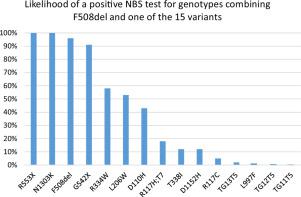当前位置:
X-MOL 学术
›
J. Cyst. Fibros.
›
论文详情
Our official English website, www.x-mol.net, welcomes your
feedback! (Note: you will need to create a separate account there.)
Penetrance is a critical parameter for assessing the disease liability of CFTR variants
Journal of Cystic Fibrosis ( IF 5.4 ) Pub Date : 2020-11-01 , DOI: 10.1016/j.jcf.2020.03.019 A Boussaroque 1 , M-P Audrézet 2 , C Raynal 3 , I Sermet-Gaudelus 4 , T Bienvenu 1 , C Férec 2 , A Bergougnoux 3 , M Lopez 1 , V Scotet 5 , A Munck 6 , E Girodon 1
Journal of Cystic Fibrosis ( IF 5.4 ) Pub Date : 2020-11-01 , DOI: 10.1016/j.jcf.2020.03.019 A Boussaroque 1 , M-P Audrézet 2 , C Raynal 3 , I Sermet-Gaudelus 4 , T Bienvenu 1 , C Férec 2 , A Bergougnoux 3 , M Lopez 1 , V Scotet 5 , A Munck 6 , E Girodon 1
Affiliation

|
BACKGROUND
Major issues of newborn screening (NBS) for CF are the assessment of disease liability of variants and of the penetrance of clinical CF, notably in inconclusive diagnosis. The penetrance of CF is defined as the risk of a particular genotype to lead to a CF phenotype. METHODS
We aimed to get insight into the penetrance of CF for fifteen CFTR variants: 5 frequent CF-causing and 10 classified as of varying clinical consequence (VCC) or associated with a CFTR-related disorder (CFTR-RD) in CFTR2 or CFTR-France databases. The penetrance was approached by: (1) comparison of variant allelic frequencies in CF patients (CFTR2) and in the general population; (2) estimation of the likelihood of a positive NBS test for the 14 compound heterozygous with F508del and the F508del homozygous genotypes, defined as the ratio of detected/expected number of neonates with a given genotype in the 2002-2017 period. RESULTS
A full penetrance was observed for severe CF-causing variants. Five variants were more frequently found in the general population than in CF patients: TG11T5, TG12T5, TG13T5, L997F and R117H;T7. The likelihood of a positive NBS test was 0.03% for TG11T5, 0.3% for TG12T5, 1.9% for TG13T5, 0.6% for L997F, 11.7% for D1152H, and 17.8% for R117H;T7. Penetrance varied greatly for variants with discrepant classification between CFTR2 and CFTR-France: 5.1% for R117C, 12.3% for T338I, 43.5% for D110H and 52.6% for L206W. CONCLUSION
These results illustrate the contribution of genetics population data to assess the disease liability of variants for diagnosis and genetic counselling purposes.
中文翻译:

外显率是评估 CFTR 变异的疾病倾向的关键参数
背景 CF 新生儿筛查 (NBS) 的主要问题是评估变异的疾病倾向和临床 CF 的外显率,特别是在不确定的诊断中。CF 的外显率定义为特定基因型导致 CF 表型的风险。方法我们旨在深入了解 CF 对 15 种 CFTR 变体的外显率:5 种常见的 CF 导致和 10 种归类为不同临床后果 (VCC) 或与 CFTR2 或 CFTR 中的 CFTR 相关疾病 (CFTR-RD) 相关的疾病。法国数据库。通过以下方式接近外显率:(1) CF 患者 (CFTR2) 和普通人群中变异等位基因频率的比较;(2) 估计具有 F508del 和 F508del 纯合基因型的 14 个复合杂合子的 NBS 测试阳性的可能性,定义为 2002-2017 年期间具有特定基因型的新生儿检测/预期数量的比率。结果 观察到严重 CF 引起的变异的完全外显率。五个变异在普通人群中比在 CF 患者中更常见:TG11T5、TG12T5、TG13T5、L997F 和 R117H;T7。TG11T5 阳性 NBS 测试的可能性为 0.03%,TG12T5 为 0.3%,TG13T5 为 1.9%,L997F 为 0.6%,D1152H 为 11.7%,R117H 为 17.8%;T7。CFTR2 和 CFTR-France 之间存在差异分类的变体的外显率差异很大:R117C 为 5.1%,T338I 为 12.3%,D110H 为 43.5%,L206W 为 52.6%。结论 这些结果说明了遗传学群体数据对评估变异的疾病倾向性以进行诊断和遗传咨询的贡献。
更新日期:2020-11-01
中文翻译:

外显率是评估 CFTR 变异的疾病倾向的关键参数
背景 CF 新生儿筛查 (NBS) 的主要问题是评估变异的疾病倾向和临床 CF 的外显率,特别是在不确定的诊断中。CF 的外显率定义为特定基因型导致 CF 表型的风险。方法我们旨在深入了解 CF 对 15 种 CFTR 变体的外显率:5 种常见的 CF 导致和 10 种归类为不同临床后果 (VCC) 或与 CFTR2 或 CFTR 中的 CFTR 相关疾病 (CFTR-RD) 相关的疾病。法国数据库。通过以下方式接近外显率:(1) CF 患者 (CFTR2) 和普通人群中变异等位基因频率的比较;(2) 估计具有 F508del 和 F508del 纯合基因型的 14 个复合杂合子的 NBS 测试阳性的可能性,定义为 2002-2017 年期间具有特定基因型的新生儿检测/预期数量的比率。结果 观察到严重 CF 引起的变异的完全外显率。五个变异在普通人群中比在 CF 患者中更常见:TG11T5、TG12T5、TG13T5、L997F 和 R117H;T7。TG11T5 阳性 NBS 测试的可能性为 0.03%,TG12T5 为 0.3%,TG13T5 为 1.9%,L997F 为 0.6%,D1152H 为 11.7%,R117H 为 17.8%;T7。CFTR2 和 CFTR-France 之间存在差异分类的变体的外显率差异很大:R117C 为 5.1%,T338I 为 12.3%,D110H 为 43.5%,L206W 为 52.6%。结论 这些结果说明了遗传学群体数据对评估变异的疾病倾向性以进行诊断和遗传咨询的贡献。











































 京公网安备 11010802027423号
京公网安备 11010802027423号